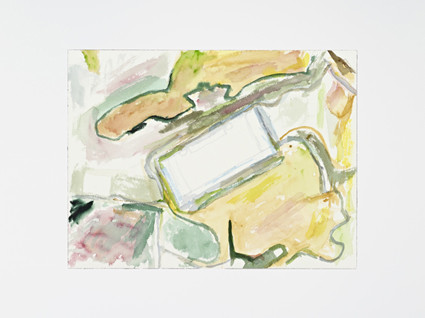John Kelsey
19 Jan - 02 Mar 2013
JOHN KELSEY
19 January - 2 March 2013
Watercolors are what the creative ones in the family did while summering on Cape Cod. It was a default activity, like boating, and another way of avoiding each other by the sea. Those small, thrifty, earnest, joyless, protestant landscapes were my first, wrong idea of art.
In this new series of landscapes with data centers, a pastoral feeling is sometimes assisted by helicopter and satellite views. Owned and operated by companies like Apple, Google and Facebook (also by the government), data centers are the physical reality behind the myth of immaterial production and the knowledge economy, the actual places where information goes when we send it to “the cloud.” These are the massive, refrigerated, high security “server farms” and “data barns” that store and process everything we do when we work and socialize via networks, including information we no longer use or remember. Occasional interior views gaze down “cold aisles” of data processors.
Some works actually were painted on Cape Cod: Please respect my decision to end this long-distance relationship because it is not working for me and I do not want to talk to you or see you – both portraits painted from life last summer. Other abstractions were made by painting around randomly scattered coins. And there are three paintings of names: Rosamund Blazek, Faustine Honts and Mavis Maung – the uncanny, not quite real sounding senders of spam emails advertising discount pharmaceuticals for erectile dysfunction and depression. The watercolors are mounted flat like photo prints on sheets of plexiglas and aluminum, and framed without glass for a more direct encounter with their watery, sensitive qualities.
Three texts are composed using only the content of mass emails sent by Blazek, Honts and others. Random fragments of appropriated literature are often copied and pasted into such messages, and like the names are probably means of evading spam filters. Here the fractured writing is reorganized in poem-like forms – hallucinations of a potential literary space within the post-literary space of cyber-communication. The images in these compositions are my own cell phone photos, processed through Instagram.
J.K.
19 January - 2 March 2013
Watercolors are what the creative ones in the family did while summering on Cape Cod. It was a default activity, like boating, and another way of avoiding each other by the sea. Those small, thrifty, earnest, joyless, protestant landscapes were my first, wrong idea of art.
In this new series of landscapes with data centers, a pastoral feeling is sometimes assisted by helicopter and satellite views. Owned and operated by companies like Apple, Google and Facebook (also by the government), data centers are the physical reality behind the myth of immaterial production and the knowledge economy, the actual places where information goes when we send it to “the cloud.” These are the massive, refrigerated, high security “server farms” and “data barns” that store and process everything we do when we work and socialize via networks, including information we no longer use or remember. Occasional interior views gaze down “cold aisles” of data processors.
Some works actually were painted on Cape Cod: Please respect my decision to end this long-distance relationship because it is not working for me and I do not want to talk to you or see you – both portraits painted from life last summer. Other abstractions were made by painting around randomly scattered coins. And there are three paintings of names: Rosamund Blazek, Faustine Honts and Mavis Maung – the uncanny, not quite real sounding senders of spam emails advertising discount pharmaceuticals for erectile dysfunction and depression. The watercolors are mounted flat like photo prints on sheets of plexiglas and aluminum, and framed without glass for a more direct encounter with their watery, sensitive qualities.
Three texts are composed using only the content of mass emails sent by Blazek, Honts and others. Random fragments of appropriated literature are often copied and pasted into such messages, and like the names are probably means of evading spam filters. Here the fractured writing is reorganized in poem-like forms – hallucinations of a potential literary space within the post-literary space of cyber-communication. The images in these compositions are my own cell phone photos, processed through Instagram.
J.K.

